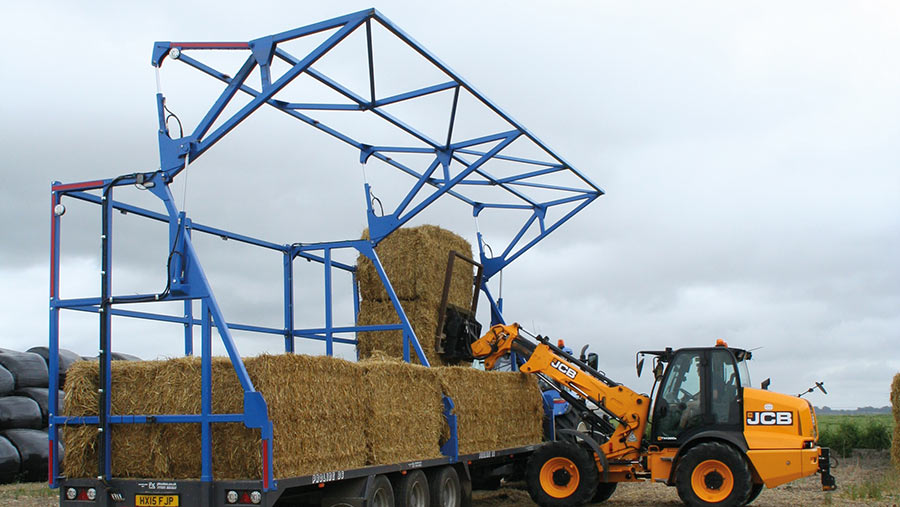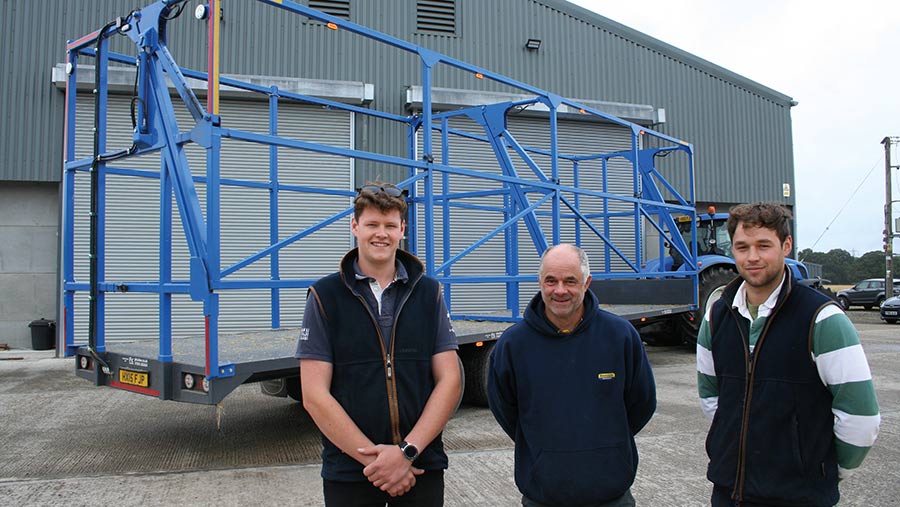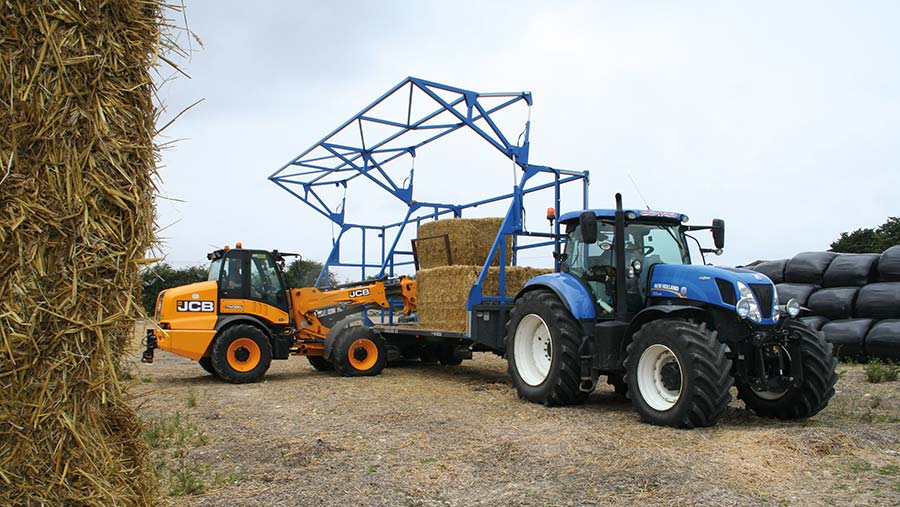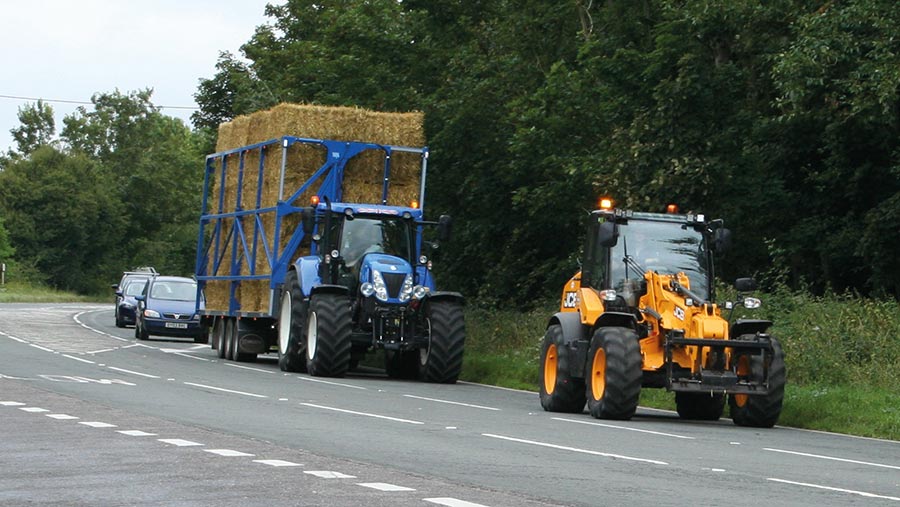Driver’s view: Load & Go bale trailer speeds field clearance
 © Peter Hill
© Peter Hill A strong emphasis on dairy cow health was a big factor in deciding the size and spec of a new bale trailer for the team at MES Dart & Partners.
They run two family farms, plus contract farming and contract silage-making and spraying, on the outskirts of Wallingford in south Oxfordshire.
Apart from wanting to clear straw bales from fields more cost-efficiently, using fewer people and machines, manager Mark Oldroyd says another key objective was to end each combining day with all bales loaded, carted, stacked and sheeted.
See also: 14t and 16t silage trailer buyers guide
“We get through a lot of straw for bedding and feed and want that straw in optimum condition to help maintain cow health as part of a strategy to minimise antibiotics use,” he explains.
“What we don’t want to see is straw bales still in the field when it’s raining; we want them stacked, covered and dry at the end of the day, and that was a key consideration in deciding the size and specification of the new trailer.”
The farming operation grows 880ha of arable crops, 400ha of grass and 200ha of forage maize, while also milking 650 cows in two herds housed in cubicle buildings.
In addition to bedding for youngstock, straw is chopped and incorporated in rations fed year-round.
It is stored in covered stacks of 120x130cm bales from a Massey Ferguson MF190 baler, this year operated behind a 374/409hp New Holland T8.410 Genesis that will also handle grass mowing for silage, as well as drilling of all arable crops.

Tele-loader operator Andrew Gilmore, manager Mark Oldroyd, and trailer operator Will Oldroyd. © Peter Hill
The baler goes straight in behind the 12.5m (41ft) Claas Lexion 780 combine, with the hauling team following on to shift about 4,000 bales by the end of harvest.
“We like to do 30 to 40ha of combining and finish the day with the field cleared,” says Mark Oldroyd.
“That avoids carting on a wet day, with its impact on the soils and dragging mud on to roads, and it means that when we can’t combine, the farm team is available for essential maintenance, servicing and other wet-day jobs.”
Load & Go frame
The trailer was built by Heath Engineering and sourced through Paul Kelloway at PK Sales for last year’s harvest.
It has a 10.9m (36ft) long deck and triple-axle running gear with multi-leaf suspension. That’s more suitable than air suspension, reckons Mark Oldroyd, which performs well on the road but is not up to the rough and tumble of field work, in his view.
“When the trailer’s in the field you can see the axles and suspension working away to keep the load evenly distributed over the six tyres and it also tows smoothly on the road,” he says.
The most eye-catching and very obvious feature, however, is the huge bolt-on Load & Go frame, which was inspired to some extent by the three-sided wire rope structure built on the three converted artic trailers that the one new unit has replaced.
While that home-made solution was helpful, it required strapping to secure the bales, whereas the four-sided Load & Go frame keeps the bales gripped tight under hydraulic pressure.
The structure is big enough to accommodate 24 bales arranged in three layers.
For loading and unloading, the entire right-hand side opens up on three hydraulic cylinders – one at each end and one on a central division half way along the trailer bed – and closing this section is all that’s needed to secure the big load for the haul back to the yard.

© Peter Hill
Clearing fields
Will Oldroyd, who operates the trailer behind a 260/270hp New Holland T7.270, says the time saving is significant.
“At least half an hour per load, because there’s no time spent strapping and unstrapping, and on a really good day we can shift 10 to 12 loads – that’s 240 to 288 bales cleared off the field and safely stored.
“It’s long and it’s high despite running on low profile tyres to keep the height down as much as possible, but we can get most places with it and the tractor has enough power to be on top of the job in all situations.”
The field-to-yard hauling routine sees colleague Andrew Gilmore running the farm’s 2019-plate JCB TM320S telescopic wheeled loader ahead of the big trailer.
This is so that he can warn on-coming traffic on narrow lanes and relay information on potential issues to Will Oldroyd by two-way radio – as much part of the farm’s safety and courtesy policy as it is to get from A to B as quickly as possible.
In the field, the trailer is kept to the tramlines to minimise soil compaction and ensure it has a firm base to make its way along while the telehandler feeds in bales.
“My routine is to stack two bales then split the pair to form the bottom layer, and then stack and load two at a time to complete the load,” explains Mr Gilmore.
“The loader would manage to lift three, but two big bales is a comfortable weight for running to the trailer and I get a decent view ahead.
“With three bales, the bottom tines of the grab would be pulling through and we like to have bales in good shape and condition.”
Back to the yard
After dropping off the grab to avoid running on the road with exposed tines, the JCB loader takes up position as the lead machine again for the haul back to the yard.
By the time a duplicate grab has been coupled, the Load & Go frame has been opened and the bales are ready for off-loading and stacking.
“It’s another important safety feature that no one is exposed to potentially unstable and very heavy bales during either the loading or unloading process,” emphasises Mark Oldroyd.

© Peter Hill
“With a conventional trailer, once the straps are off there’s always a possibility of accidentally pushing bales off the far side of the trailer when unloading – but not with our trailer.
“And there’s no need for anyone to be walking around it anyway. The lads can stay on their machines for the entire process.”
The spec
Before settling on a final design, everyone involved pitched in with ideas for the size and features of the new trailer, including details such as the rear-view camera and the LED road light clusters on the back of the deck and repeated high up on the frame.
There are two rows of orange marker lights along each side of the deck and top rail that also flash as turn indicators, plus red (rear) and yellow (side) reflective strips that serve to reinforce the trailer’s presence on public roads.
Since it’s bolted on, the bale retaining structure could theoretically be lifted off to release the trailer for other work, although Mark Oldroyd is not enthusiastic about that possibility.
He says: “I prefer to think of this as a trailer dedicated to our big bale haulage workload, and in that role it has far exceeded our expectations, not only in the way it performs but also in the way it has enabled us to meet our field clearance objectives.
“It’s made bale haulage a much smoother, more efficient operation using half the resources we needed before but still being able to keep up with the baler, and it’s a much safer solution for travelling on local roads that only get busier.”

